The WW2 ‘Flower’ class is famous from being basically a whaler adapted to ASW and delivered by myriads of small yards in the British isles and commonwealth, Canada in particular. Despite their slow speed and small size, they did their job well against the onslaught of U-Boats in the Atlantic. However there was another “Flower” class. Those of the first battle of the Atlantic. That of the great war. The name came because of… shortage of ideas after battleships, cruisers and destroyers bleed the list dry. In WW2 in addition to flowers, rivers, woods, lochs, mountains, insects, birds, even dances, were used. Perhaps because of a well-known British passion for gardens, for this class the name stuck, and crossed two generations, despite its decidedly un-warlike qualities. But if the purpose was the same, hunting down U-Boats, while being be built in civilian shipyards. Here is the story of the original “Flower class” and the other sloops of the Royal Navy during WW1, most of these variations on the theme of the “Q-Ship”.
Summary:
-
Flower class (“convoy sloops”)
- Acacia class — 24 ships, 1915
- Azalea class — 12 ships, 1915
- Arabis class — 36 ships, 1915–1916
- Aubrietia class — 12 ships, 1916–1917
- Anchusa class — 28 ships, 1917–1918
- 24 class — 22 ships, 1918–1919
Still ‘sloops’ but out the Flower class
- P class — 45 ships, 1915–1917
- Kil class — 81 ships, 1917–1919
- PC class “Q-ships” — 19 ships, 1917–1918
Sloops before and during WWI
Sloops of the XIXth century.
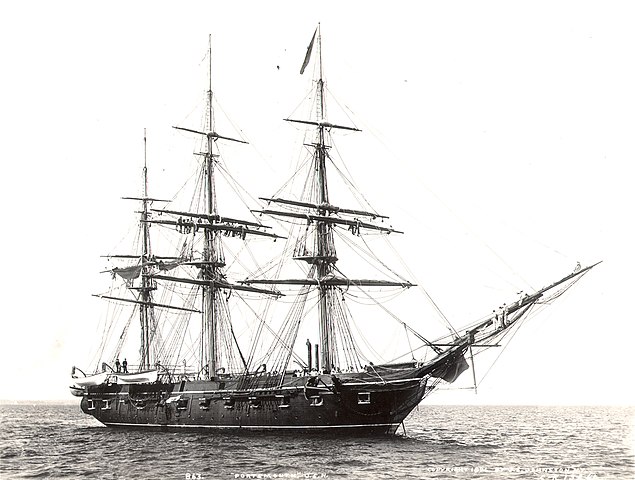
USS Portsmouth, a large sloop-of-war in 1896.
The industrial age saw the traditional warship order gradually shift in types, with some disappearing, other appearing, and most evolving in between. The “sloop” is an ancient term straight from the XVIIth century Netherlands. This was originally the Dutch single-mast Sloep. Fast, nimble and agile it had a simple headsail and mainsail in bermuda configuration, of a Gaff-rigged one with a gaff topsail in the XIXth. Some became even more complex in their rigging while still keeping their single mast, such as the square-rigged sloop. Some already were armed, and kept their excellent speed. They were fit for corsairs and smugglers alike.
As steam started to seep in the XIXth century, a fringe below the frigate level saw an intermediate type, much faster and better armed than a gunboat, but less than a corvette.
In the Royal Navy it was called the sloop-of-war. The French, Dutch and German navies called them “aviso”, because they were used as messenger ships, carrying “avis” or notes to officers in a battle line. They could be either large vessels called the Ship sloop, three masted, or the smaller Brig sloops, both born in the 1770s and converted gradually to steam one century afterwards. However in the 1860s the “ships-sloops” grew larger in size, reaching a step above the corvette (generally two masted) and the frigate.
Like them, three-masted with a full artillery deck and one or two carronades on traversing mounts. Steam generated steam frigates, steam corvettes and steam sloops, all with a number of cannons making them unrated vessels. As ships of the line gradually disappeared, the single artillery deck became the norm, causing the abolition of the traditional rating system and soon after, the sloops, corvettes and frigate denominations. Instead, with the advent of the torpedo, typology now relied on the specialist type: Torpedo Boat, Destroyer, Gunboat, Cruiser or Battleship. In the 1860-70s, the Royal Navy accepted into service a wide range of “screw sloops”, li,e the Cameleon class (1860), Rosario and Amazon class (wooden hull), and the Fantome, Osprey, Doterel, Dolphin, Mariner, Nymphe, Beagle, Alert, Phoenix, Condor and Camus, all composite sloops. They all became “gunboats” in the new classification. They could be seen more in detail in the British WWI gunboats article.
However as WW1 broke out, the “naval dust” that could have played a role down the ladder did not existed anymore. Torpedo boats were not fit for long patrols and especially hunting down submarines, and as the threat became obvious from 1915, measures were taken already to devise specialized ships that fit no previous category. They were given back these old forgotten denomination of sloops and frigates. These new vessels created their own category. They were not gunboats, as the latter were meant for stations (mostly colonial). They were not intended for fleet deployments, but escort. The escort system was indeed revived, but destroyers could not be sent defending these: They were needed in the fleet, having their well defined roles at the sides of larger vessels, and running at the same fast speed.
The new escort vessels however, were not to be armed with torpedoes as they were not intended to prey on fast warships, nor had powerful and oil-hungry turbines to achieve the best speeds: They were intended to run long distances at half that speed, just slightly better than the best average trade ship in the convoy.
Birth of the British Anti Submarine Warfare
Changes in policy for the U-Boat campaign
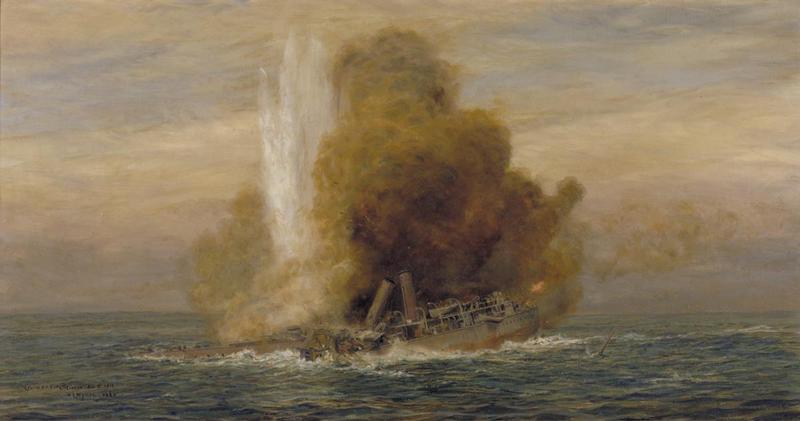
HMS Pathfinder sunk by an U-boat in 1914
Anti Submarine Warfare (ASW) is indeed born with WW1. Before this, the type rarely had been used in such a scale and area, neither with such decisive goal. While the Hochseeflotte was maintained largely in a state of dissuaded inactivity after Jutland, the Kaiser decided to step-up the effort with submarines deployed as a way to hunt down enemy vessels, and later counter-blockade measure, it gradually became an all-out offensive one. The blockader (The Royal Navy) was becoming the blockaded. What restrained until then their efficiency was the complicated set of rules (called “cruiser rules”) for commerce raiding and war prizes, signed by Germany before the war: The U-Boat captain was to inspect the ship, surfaced, first, then if at least part the cargo was indeed destined to a belligerent, either sunk it after ensuring the safety of the crew, or just seized, and brought under escort either in a neutral port or if possible, that of Germany.
Of course in wartime it became near-impossible to apply these, without compromising the submarines first from 1917 when naval aviation and ASW air patrols became much more common. The usual way was to inspect the ship if neutral (and sink it), or sink it outright if belligerent. However incidents started early on: On 26 October, U-24 attacked an unarmed merchant ship without warning, the Belgian troopship Admiral Ganteaume, with many refugees aboard. The ship however survived and arrived in Boulogne. On 30 January 1915, U-20, torpedoed on sight Ikaria, Tokomaru and Oriole, and later torpedoed (but missed) the hospital ship Asturias. Eventually on 4 February 1915, the first unrestricted campaign against Allied trade started.
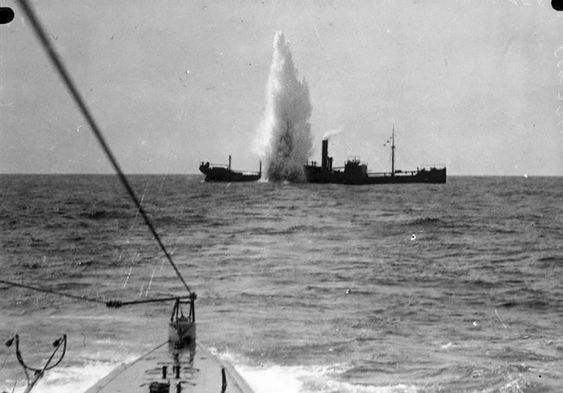
It was suspended famously after SS Lusitania, carrying US citizens, was sunk, on 7 May 1915. In early 1916, the Hochseeflotte asked support of the U-Boat fleet again, in order to reduce the Royal Navy’s strength to better balance chances of an all-out naval battle. The classic scenario was to lure and draw British ships (with battlecruisers at first) on prepared “ambushing” positions with a curtain of U-Boats and minefields. Several attempts were made, the most famous ones being at Jutland. But that plan never really worked and U-Boats were sent to patrol and fire on targets of opportunity. Encounters were by chance and success, expectedly low.
So after October 1916, the Kaiser confered with the Kaiserliches marine staff and they agreed to resume commerce raiding, with more submarines (which were given industrial priority) and a better organization to spot convoys, just recently organized. In addition, it was to be unrestricted, so even neutral ships could expect to be sank without warning. It was almost assured in early 1917 to bring America into the war, but it was gambled at the time, the war would end in the east, and fresh troops could be bring out to the west in full force and defeat the entente before US troops came in force. The first months were spectacular successes: By February 1917 414,000 GRT, March 500,000, April over 600,000 and May 860,000 GRT when it peaked. However afterwards, British ASW armada and methods started to tell, and soon the US Navy brought its might as well.
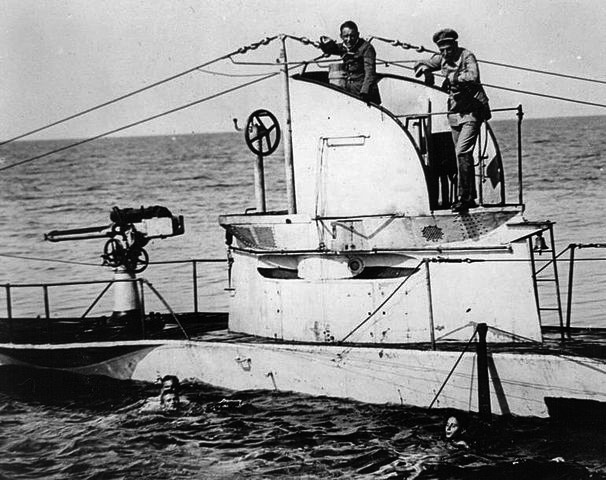
U-27, sank in August 1915
British counter-measures
These were at first largely ineffective. The most effective wyay to sink an U-Boote when spotted was simply trying to ram it. Many merchantmen risked the manoeuver and rarely hit the submarine, as in fact it just forced it to submerge. Half of all attacks were foiled this way in 1915, which in response freed many U-boat captain to attack without warning. On 20 March 1915, SS Brussels did this to U-33, but her captain, Charles Fryatt was later executed after the ship was captured by the Germans, in June 1916, to international outcry. If a merchant vessel was armed in any way, this also freed the U-Boat captain for any bound to peacetime convention.
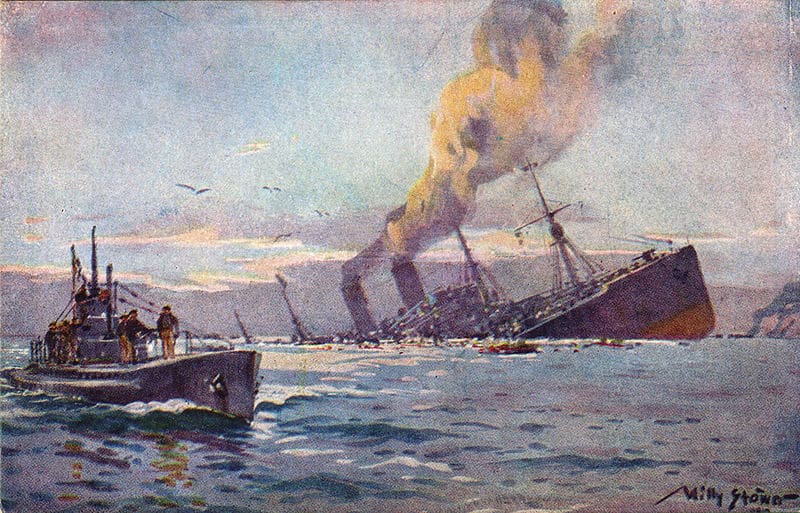
In 1915 however, the British tried to revive an old tactic already use in the XVI to XIXth centuries, disguise. The trick was to arm and man a merchant vessel with hidden guns and let the enemy submarine surface and close for inspection, then unmasking and opening fire at point blank range. This became the “Q-ship” tactic (Q for decoy). In 1915, three U-boats were sunk that way, and two trawlers hiding a following submersible. In June, U-40 was sunk by HMS C24 that way, when closing to inspect SS Taranaki. In July, U-23 was sunk by C-27 shadowing SS Princess Louise. Also in July, U-36 was sunk by the Q-ship Prince Charles, as were U-27 and U-41.
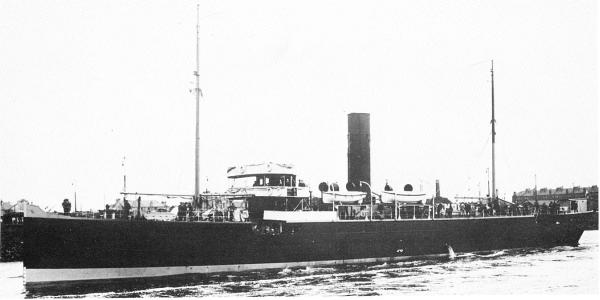
Q-Ship HMS Tamarisk
Since, detection and attack of submerged U-boats was impossible. There was at least a trawler that tried to damage an u-boat periscopes with hammers when passing by, or dropping guncotton bombs, use nets ensnare them. The admiralty even tried to equip the destroyer HMS Starfish with a spar torpedo. But at the end of the first phase (1915), on 15 U-Boats has been sunk in various ways. In return they managed to sank 370 ships (750,000 GRT).
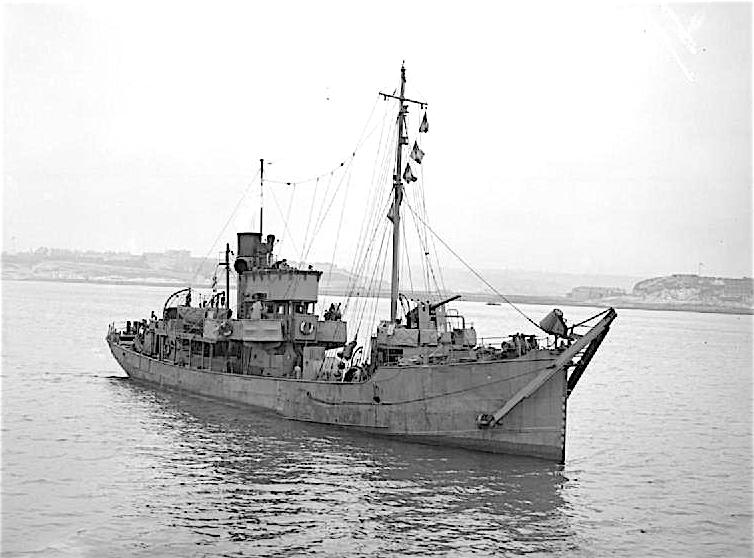
HMS Swansea Castle, and emergency construction program ASW trawler in 1918.
The “Flower” class sloops
The Royal Navy looked at a way in early 1915 already to muster its presence of ships while sparing unused yards and materials if possible. Way after that, in late 1917, the convoy system was re-implemented, and these sloops became specialized escort ships.
With a typical British humor they were popularly called the “herbaceous borders”, a reference to the last century popular adage about the Royal Navy being “Britain’s best bulwarks are her wooden walls”, very much in the spirit of the Athenian prophecy before Salamis. The garden border was also very popular in the UK, seeping through movies like the Monthy Python’s Holy grail.
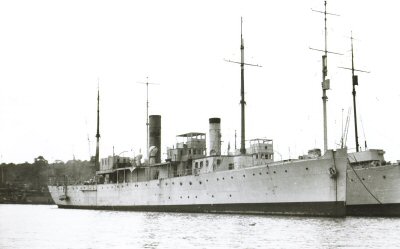
HMS Bryony in 1917
The Flower class were defined by the Emergency War Programme in 1914 already. Since British naval yards were all full, between repair, drydock maintenance and new constructions, the sloops were designed to be built in merchant shipyards instead. The initial three groups were purpose-built “fleet minesweepers”, with triple hulls and reinforced bow, giving extra protection, both when ramming and from mine damage. After 1916, their role as minesweepers was relegated after ASW escort. They all were tasked of convoy escort duty refitted with depth charges and 4.7-inch rapid fire naval guns.
The first group of fleet minesweepers comprised the Acacia-class (1915), 24 vessels in two batches, with two losses during the war.
The second group called Azalea-class (12 vessels) the same year were slightly modified and two were sunk in action.
The last group called Arabis-class comprised 36 modified vessels in 1915-16, taking many early service lessons into account. Eight more were built for the French Navy. Five were sank in action (and one French). Interestingly, all were not lost in the north sea and channel: A further two ships, HMS Gentian and Myrtle were lost to mines in the Baltic Sea, on 16 July 1919, while supporting “White” Russians. This in total made for ten losses.
The second serie was modified as Submarine decoys (warship-Qs). They were purely designed for ASW warfare, with hidden guns and a “merchant marine” appearance to lure out unsuspecting u-Boats. These “warship-Qs” were the first specifically designed as ASW vessels, had great hopes planes on them to win the Battle of the Atlantic.
They comprised two classes: The Aubretia-class, 12 built in 1916 (two sunk) and the Anchusa-class, 28 vessels built in 1917, six sunk.
Some served as patrol vessels i colonial stations during the interwar but nearly all had been disposed before 1939. Their names were retaken for the new, and better known Flower-class corvettes.
Two Anchusa class ships, HMS Chrysanthemum and President (ex-Saxifrage, renamed in 1922) were anchored on the River Thames, as drill ships until 1988, so seventy years of loyal service, quite a record. HMS Chrysanthemum was eventually scrapped in 1995 but President was preserved and can be visited as a WWI relic with HMS Caroline in Belfast, and the monitor HMS M33 in Portsmouth. Other were in service in WW2, see the details below.
Acacia class Fleet sweeping Sloops (1915)
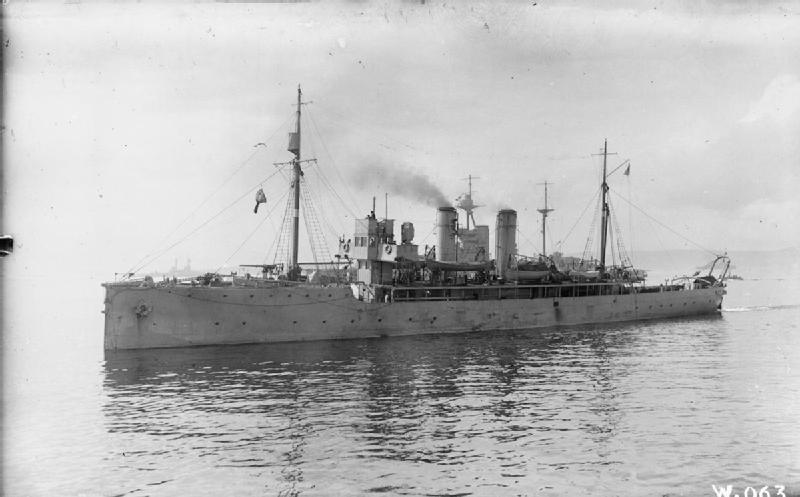
Swan Hunter: Acacia, Anemone
Earle: Aster
Scott: Bluebell, Daffodil, Magnolia
Barclay Curle: Dahlia, Daphne, Foxglove, Hollyhock, Lily, Mallow
Lobnitz: Honeysuckle, Iris
Connell: Jonquil, Laburnum
Napier & Miller: Larkspur
McMillan: Marigold, Mimosa, Primrose
Henderson: Sunflower
Dunlop Brenner: Veronica
In addition to their minesweeping role, these ships were designed by the admiralty as auxiliaries for general service, towing and transport of troops and storage. They were based on a DNC design, on Mercantile scantlings which was simple and robust to be built by non-specialist yards. High standardisation helped to achieve a high speed construction rate. So much so, that if most took nearly one year to built, some were completed in little more than four months and a half.
They had a study, reliable 4-cylinder triple expansion engine, while steam came from two cylindrical boilers, but of course top speed was limited to 16 knots. Even if they were designed for 1,400 hp (1,040 kW) or even 1,800 hp (1,340 kW), enough to reach 17 knots (31 km/h), it was realized on trials they needed to overheat their machinery to achieve 2,200 ihp (1,640 kW) for this, and therefore it was limited in practice to far less, enough to achieve 16.5 knots at best. Range was 2,000 nmi (3,700 km) at 15 kn (28 km/h) thanks to a bulk storage of 250 tons of coal.
Like all single-propeller ships they had a large turning circle, and even carried steadying sail to assist in keeping their head to wind. They were unarmoured, except a stray of 8 or 12 mm (.3 to .5 in) over their ammunition magazine, far aft. The box was sturdy enough that it was in one occasion at least blown into the air without detonating after a mine blast.
Later vessels were built with treble-thickness plating around the bow to ramming, and reinforced forecastles and bulkheads forward for the same reason. The first batch of 12 was authorized on 1st January 1915. The second on the 12th. They were delivered between May and September the same year. They were used as minesweepers until 1917 and then turned to convoy escort.
Most were sold in the early 1920s to civilian companies, disarmed. Lavender was torpedoed in May 1917, Aster jut a mine in 1917. Foxglove saw WW2 and was sold in 1945 while Jonquil served with the Portuguese Navy and Laburnum became a guardship in Singapore, sunk in February 1942 by IJN aviation.

Technical specifications
-Displacement: 1,200, 1300 t FL
-Dimensions: 76.2 wl, 80 m oa x 10.1 x 3.4 m (262 x 33 x 12 ft)
-Propulsion: 1 shaft TE 4 cyl, 2 cyl. boilers, 1,800 hp. 16 knots
-Armament: 2x 76 mm (12 pdr), 2x 47 mm AA (3 pdr), variable
-Crew: 77-90
Azalea class Fleet sweeping Sloops (1915)
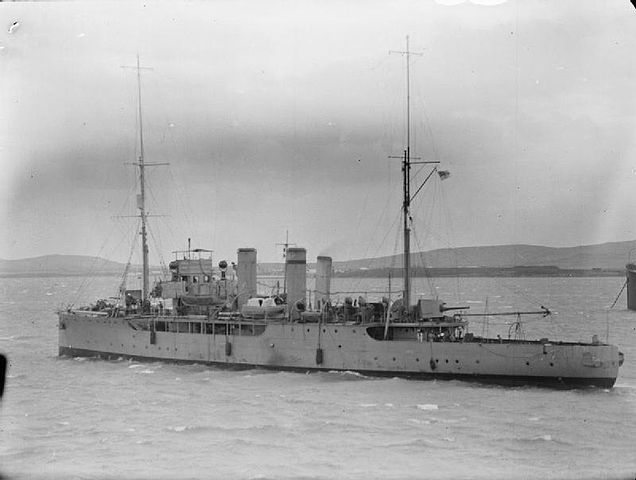
Barclay Curle: Azalea, Begonia
Bow McLachlan: Camellia
Greenock & Grangemouth: Carnation, Clematis
Lobnitz: Heliotorpe, Myrtle
Swan hunter: Jessamine, Zinnia
Napier & Miller: Narcissus
McMillan: Peony, Snowdrop.
This second class was virtually a third batch of the first class, ordered in May 1915 with some modifications: They had a heavier armament, in the likelihood of German raids during their sweeping duties. It was hope to provide them all with 4.7 in guns, but it was in short supply and only part of them had, the others went with the smaller 4-in (102 mm). In other respects they were virtually identical, completed in September-December 1915. HMS Begonia was the first converted Q-ship, at Aulbowline near Queestown in 1916-17. He silhouette was altered to an inocuous coaster and she was recommissioned in August 1917, known as Dolcis, Jessop and Q10. She rammed the U-Kreuzer U-151 off Casablanca, but sank as a result. Myrtle ws sunk in the gulf of Finland in 1919, by a mine. Zinnia went to the Belgian Navy.
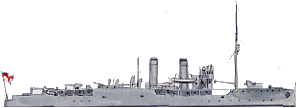
Technical specifications
-Displacement: 1,210, 1350 t FL
-Armament: 2x 120 mm (4.7 in), 2x 47 mm AA (3 pdr), variable
Arabis class Fleet sweeping Sloops (1915)
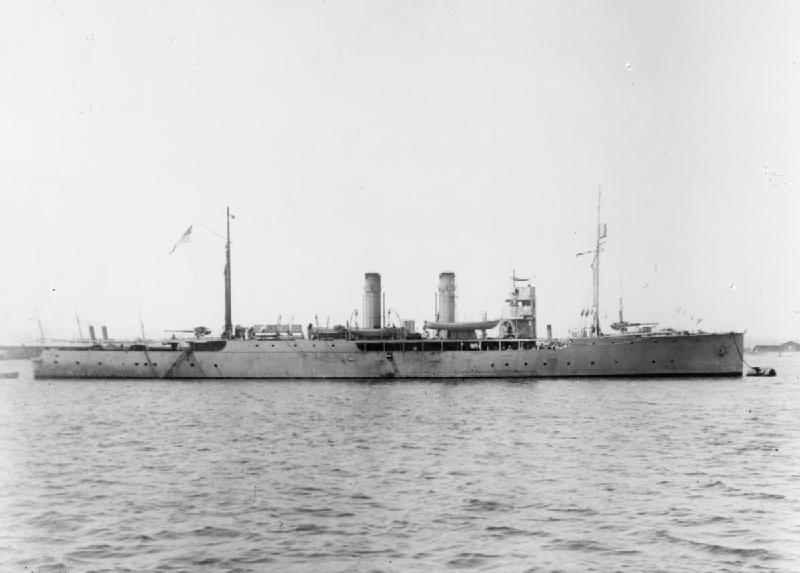
Earle: Alyssum, Amaryllis
Henderson: Arabis, Asphodel, Berberis
Barclay Curle: Buttercup, Campanula, Celandine, Cornflower
Bow McLachlan: Cyclamen
Greenock & Grangemouth: Delphinium, Genista
Lobnitz: Crocus, Cyclamen
Connell: Gladiolus, Godetia, Hydrangea
Greenock & Grangemouth: Gentian, Geranium
Simons: Lobelia, Lupin
Dunlop Brenner: Marguerite, Mignonette
Bow McLachlan: Myosotis
McMillan: Nasturtium
Hamilton: Nigella, Pansy
Workman Clark: Pentstemon, Petunia
Swan hunter: Primula, Poppy
Richardson Duck: Rosemary
Ropner: Snapdragon
Rennoldson: Valerian
Blyth: Verbena
Irvine: Wallflower, Wisteria
The admiralty wanted a new class with an improved engine and larger dimensions, which, they hope, could reach at least one half knot more. Most improvements came from experience, and when the blueprints were ready, they were ordered in three batches: One of these innovation, ported on the next two batches during construction was the filling of their bow and wing compartment with 50 tons of cork in order to improved floatation in case of flooding. Armament was copied over the previous Azalea, but some were fitted with light 4-in guns. In addition to the 36 ordered by the admiralty and delivered in record time by the 19 yards contracted, eight more were built for the French Navy (see ww1 French escort section).
Most were sold in the 1920s-1930s, but Geranium and Marguerite served with the RAN from 1920 and ended as target in 1937, Asphodel was sold to Denmark, Gladiolus to Portugal, Godetia to Belgium. Earle, Arabis, Genista, Gentian, Mignonette, Nasturtium, Primula, were lost in action during WW1 or in 1919. Valerian was foundered in 1926. Two more served in WW2: Cornflower and Rosemary. The first was used by a commercial company but requisitioned by the RN in 1940 and pressed back into service in Singapore when she was lost in December 1941, bombed by IJN aviation. Rosemary was an escort in the Atlantic and survived until 1947, sold for BU.
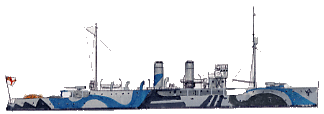
Technical specifications
-Displacement: 1,250, 1400 t FL
-Dimensions: 81.7m oa x 10.2 x 3.4 m (268 x 33 ft 6 in x 12 ft)
-Propulsion: 1 shaft TE 4 cyl, 2 cyl. boilers, 2,000 hp. 16 knots
-Armament: 2x 127 mm (4.7 pdr), 2x 47 mm AA (3 pdr), variable
-Crew: 90
Aubrietia class Convoy Sloops (1916)
Aubrietia, Andromeda, Heather, Salvia, Tamarisk, Tulip, Violia, Gaillardia, Hibiscus, Lychnis, Montbretia, Polyanthus
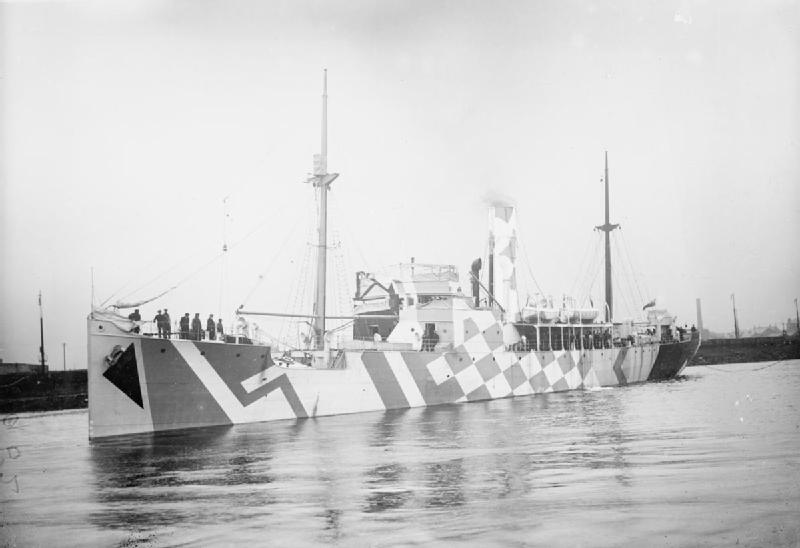
The last class was ordered in a first batch of 6, completely modified as “three-island” coasters in the hope to draw closer U-Boat. These the first admiralty Q-ships. The Aubrietia-class later received another batch order, for sloops in total under the Emergency War Programme. They were also referred to as the “cabbage class”. At first their design proceeded like the others as fleet sweeping ships with the triple hulls at the bows, armoured above-water magazine aft. But the Aubrietias were re-classified as convoy sloops during construction in 1916.
Unlike the preceding ships that were clearly military in appeareance, the Aubrietias were given a tall forecastle for 3/4 of the hull, then a raised poop, and masts with booms fore and aft, including fake hold hatches and a small dummy gun at the bow. They were built and registered to Lloyd’s standards, received Q-identifiers and false identities. Since builders were given free hands apart base specifications, accommodations were often unsatisfactory for a warship.
There was a problem though, compared to true Q-ships made from authentic trade vessels: These were still military, with fine lines seen from 3/4 fore or aft, and crew was quite large also if attempting an “abandon ship” routine if an U-Boat came close enough.
Andromeda (lead ship of the December 1916, second order) a was sold to French while on stock. Two were torpedoed and one mined during the war. HMS Chrysanthemum and HMS Saxifrage (HMS President from 1922) stayed as training vessels on the Thames until the end of the cold war. A record time for RN ships.
Technical specifications
-Displacement: 1,250, 1400 t FL
-Propulsion: 1 shaft TE 4 cyl, 2 cyl. boilers, 2,500 hp. 17 knots
-Armament: 2x 102 mm (4 in), 1x 47 mm AA (3 pdr)
-Crew: 92
Anchusa class Convoy Sloops (1917)
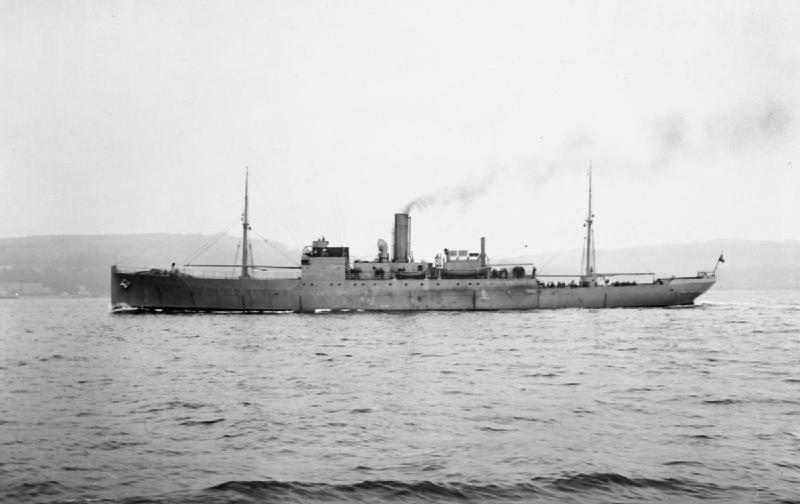
HMS Coreopsis in 1917 (IWM)
Armstrong Whitworth: Anchusa, Bergamot, Candytuft, Ceanothus (second batch) Arbutus, Auricula, Bryony, Chrysanthemum
Barclay Curle: Convolvulus, Eglantine (second batch) Coreopsis, Cowslip, Dianthus, Gardenia, Gilia, Harebell
William Simons: Spiraea, Silene
Workman, Clark: Syringa (To Egypt as Sollum) Windflower
Blyth Shipbuilding: Ivy
Greenock & Grangemouth: Marjoram, Mistletoe
William Hamilton: Pelargonium
Irvine: Rhododendron
Lobnitz: Saxifrage
Swan Hunter: Sweetbriar, Tuberose
A repeat of the Aubrietia class, also with builder’s specific accomodations and ideas. Armstrong itself joined the party and delivered the first of the batch, ordered in January 1917. A second batch was ordered in February, for a total of 28. They were larger, with a displacement reaching 1290 tonnes standard, same speed and powerplant as before. Their main guns were better hidden and for the first time they received depth charges, installed during service. They were dropped through traps under the poop. They also had bomb-throwers usually hidden behind breastworks.
All in all they were perhaps the best of the whole serie, but in the meantime, many true merchant men were converted and pressed into service as Q-ships, so this was the last class to be built of this flower class. More specialized ships were built (see below), exploring different ideas.
Anchusa, was sunk by the German submarine U-54 off the west coast of Ireland 16 July 1918, Bergamot by U-84 in the Atlantic 13 August 1917 and Candytuft in 18 November 1917, stranded near Bougie, Algeria. Arbutus by UB-65 in the St. George’s Channel 16 December 1917, Cowslip by UB-105 off Cape Spartel 25 April 1918, Rhododendron by U-70 in the North Sea 5 May 1918.
Ceanothus became the RIN Elphinstone in May 1922, wrecked on Nicobar Islands 29 January 1925.
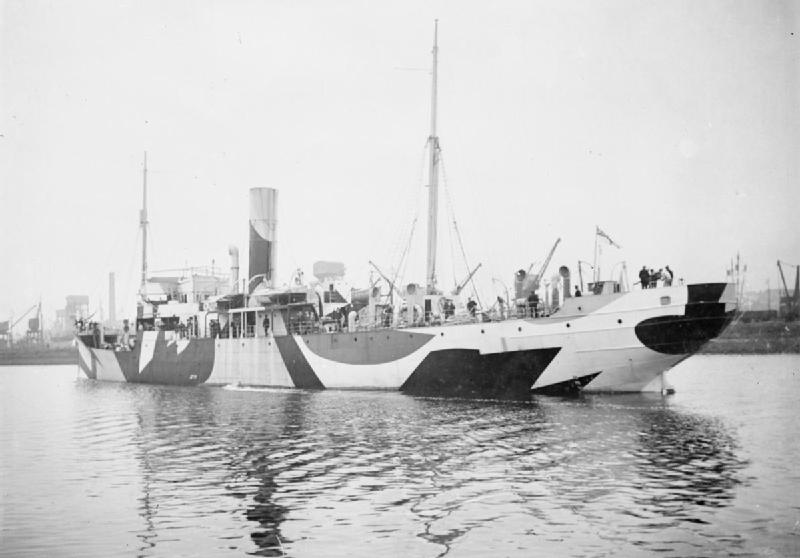
HMS Saxifrage in 1918

Technical specifications
-Displacement: 1,280, 1450 t FL
-Dimensions: 80 m oa x 10.7 x 3.5 m (262ft 6in x 35 x 11ft 6in)
-Armament: 2x 102 mm (4 in), 2x 47 mm AA (3 pdr), DCR, DCT
-Crew: 92
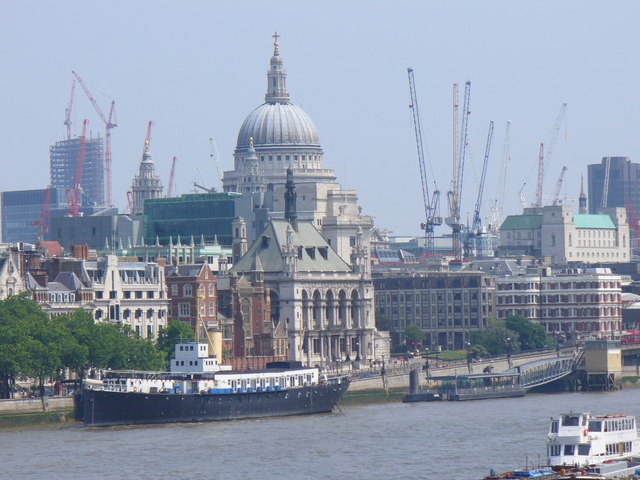
HMS President on the Thames with St Paul Capital behind in the 1990s.
’24’ class (1917)
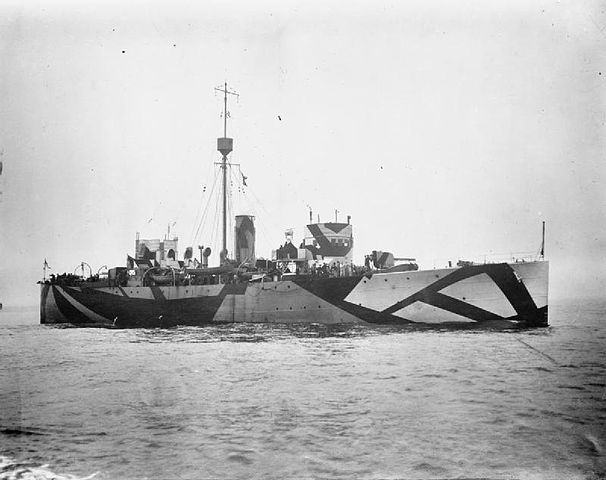
HMS Sir Bevis (IWM)
Swan Hunter: HMS Ard Patrick, Cicero, Flying Fox, Minoru, Orby, Rocksand, Spearmint, Sunstar (cancelled)
Barclay Curle: Bend Or, Harvester, Iroquois, Sefton, Silvio, Sir Bevis
Greenock & Grangemouth: Donovan, Isinglass, Sanfoin, Sir Hugo
Osbourne Graham: Galtee More, Ladas, Persimmon, Sir Visto
Blyth Shipbuilding: Merry Hampton, Ormonde.
The ’24’ class (22 ships built in 1918–1919) were totally symmetric to confuse Uboat captain over their heading. They had two identical island bridges, but were flush deck. However their single mast forward and funnel after gave some clues. They are still considered part of the flower class by most authors due to their general design and dimensions.
They were derived from the Flower-class while being double-ended, ordered as “sweeping sloops” but never used in that role. Twenty-four (hence the name) were ordered, between December 1916 and April 1917, again under the Emergency War Programm. Two however were cancelled before launch. They were named after famous racehorses, (winners of The Derby but had nothing to do with the Racecourse class (paddle minesweepers) becoming the 24 class to not confuse communications. They had also the better range of them all, carrying 260 tons of coal in their roomy hull, appreciated by the crew. This was much better than the 130 tons of the standard Flower class.
Like the Flower-class they had the same single-screw but identical deckhouses and gun shields at both ends and straight stems and sterns to make them even more symmetric. Four of those completed had a single mast aft of the funnel (in the exact center) while the rest had it forward of the funnel. It looks strange it was not chosen two masts to really perfect the silhouette. In any case, this symmetrical design included even fake anchors at the stern, and of course, fake waves painted also at the stern. They had all of course a vibrant dazzle camouflage.
Most were resold to the civilian market but HMS Flying Fox in WW2 with the RNZN (tranfs. 1920), Silvio which became HMAS Port Moresby in WW2, or HMS Merry Hampton which became a Survey ship in February 1923 as Herald and scuttled in February 1942 at Selatar, salvaged by the Japanese Navy, then IJN Heiyo in October 1942, sunk by hitting a mine on 14 November 1944.
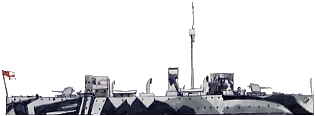
Technical specifications
-Displacement: 1,320-1,340, 1500 t FL
-Dimensions: 80.5 oa x 10.7 x 3.2 m (267 ft 6 in x 35 ft x 10 ft 6 in)
-Propulsion: 1 shaft TE 4 cyl, 2 cyl. boilers, 2,500 hp. 17 knots
-Armament: 2x 102 mm (4 in), 39 DCs
-Crew: 82
Other patrol vessels
PC-Boat class (1917)
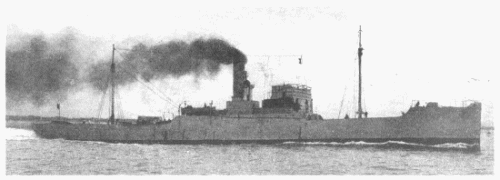
These much smaller vessels compared to the Flower class were called “decoy patrol boats”. They had a distinct civilian appearance but does not belong officially to the Flower class sloops.
These PC boats were also called the “ultimate Q-ships” and 19 of these decoy patrol boats were built in 1917–1918, featuring an even more pronounced civilian silhouette. A dedicated article will be made about them.
The last of these were very different ships:
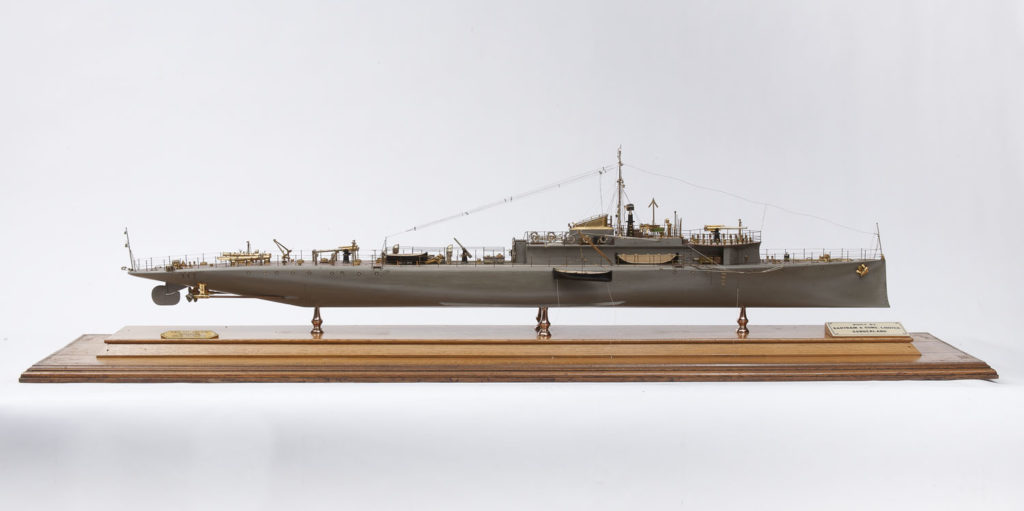
-The P class or “P-Boats” were small, fast ships designed as pure submarine hunters, or “utility destroyers”. In all, 45 ships were built in 1915–1917. An article has been dedicated to the P-Boats.
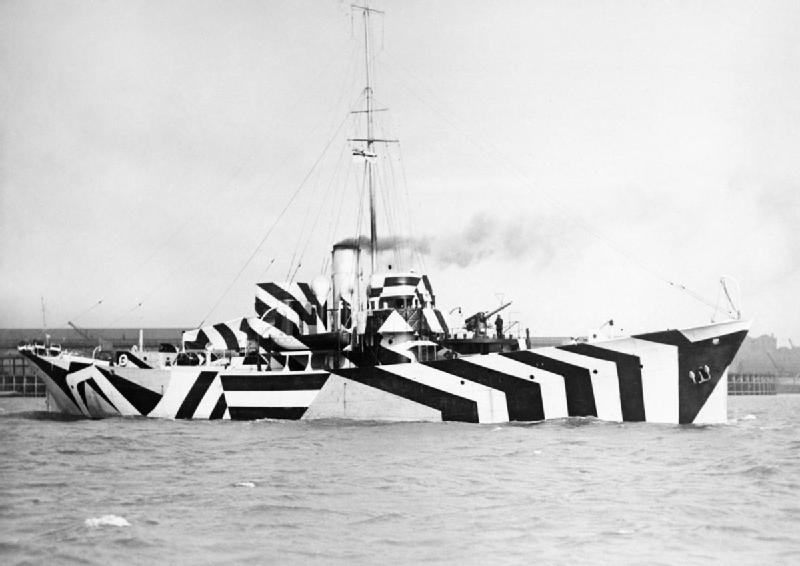
-The Kil class were ‘patrol gunboats’, were class as sloops strictly speaking by most authors, and used in the same ASW escort role from the start. In all, 81 ships were delivered by civilian yards in 1917–1919, all modelled after a whaler. They will be seen in a specific article.

PC-Boats

PC Boat, PC 55
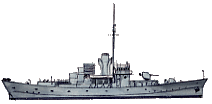
HMS Kildary, “Kil”
Src/read more
R.Gardiner Conway’s all the world’s fighting ships 1906-1921
wiki/List_of_corvette_and_sloop_classes_of_the_Royal_Navy#World_War_I_sloops
wiki/Atlantic_U-boat_campaign_of_World_War_I
naval-history.net/WW1NavyBritishAdmiraltyEstimates1919.htm
www.worldnavalships.com/arabis_class.htm
www.tynebuiltships.co.uk/Z-Ships/zinnia1915.html
www.battleships-cruisers.co.uk/flower.htm
historyhubulster.co.uk/interception-german-gunrunning-ship-easter-rising-23-april-1916/
www.naval-history.net/WW1NavyBritishShips-Dittmar3WarshipsB.htm


 Latest Facebook Entry -
Latest Facebook Entry -  X(Tweeter) Naval Encyclopedia's deck archive
X(Tweeter) Naval Encyclopedia's deck archive Instagram (@navalencyc)
Instagram (@navalencyc)





 French Navy
French Navy Royal Navy
Royal Navy Russian Navy
Russian Navy Armada Espanola
Armada Espanola Austrian Navy
Austrian Navy K.u.K. Kriegsmarine
K.u.K. Kriegsmarine Dansk Marine
Dansk Marine Nautiko Hellenon
Nautiko Hellenon Koninklije Marine 1870
Koninklije Marine 1870 Marinha do Brasil
Marinha do Brasil Osmanlı Donanması
Osmanlı Donanması Marina Do Peru
Marina Do Peru Marinha do Portugal
Marinha do Portugal Regia Marina 1870
Regia Marina 1870 Nihhon Kaigun 1870
Nihhon Kaigun 1870 Preußische Marine 1870
Preußische Marine 1870 Russkiy Flot 1870
Russkiy Flot 1870 Svenska marinen
Svenska marinen Søværnet
Søværnet Union Navy
Union Navy Confederate Navy
Confederate Navy Armada de Argentina
Armada de Argentina Imperial Chinese Navy
Imperial Chinese Navy Marinha do Portugal
Marinha do Portugal Mexico
Mexico Kaiserliche Marine
Kaiserliche Marine 1898 US Navy
1898 US Navy Sovietskiy Flot
Sovietskiy Flot Royal Canadian Navy
Royal Canadian Navy Royal Australian Navy
Royal Australian Navy RNZN Fleet
RNZN Fleet Chinese Navy 1937
Chinese Navy 1937 Kriegsmarine
Kriegsmarine Chilean Navy
Chilean Navy Danish Navy
Danish Navy Finnish Navy
Finnish Navy Hellenic Navy
Hellenic Navy Polish Navy
Polish Navy Romanian Navy
Romanian Navy Turkish Navy
Turkish Navy Royal Yugoslav Navy
Royal Yugoslav Navy Royal Thai Navy
Royal Thai Navy Minor Navies
Minor Navies Albania
Albania Austria
Austria Belgium
Belgium Columbia
Columbia Costa Rica
Costa Rica Cuba
Cuba Czechoslovakia
Czechoslovakia Dominican Republic
Dominican Republic Haiti
Haiti Hungary
Hungary Honduras
Honduras Estonia
Estonia Iceland
Iceland Eire
Eire Equador
Equador Iran
Iran Iraq
Iraq Latvia
Latvia Liberia
Liberia Lithuania
Lithuania Mandchukuo
Mandchukuo Morocco
Morocco Nicaragua
Nicaragua Persia
Persia San Salvador
San Salvador Sarawak
Sarawak Uruguay
Uruguay Venezuela
Venezuela Zanzibar
Zanzibar Warsaw Pact Navies
Warsaw Pact Navies Bulgaria
Bulgaria Hungary
Hungary

 Bundesmarine
Bundesmarine Dutch Navy
Dutch Navy Hellenic Navy
Hellenic Navy Marina Militare
Marina Militare Yugoslav Navy
Yugoslav Navy Chinese Navy
Chinese Navy Indian Navy
Indian Navy Indonesian Navy
Indonesian Navy JMSDF
JMSDF North Korean Navy
North Korean Navy Pakistani Navy
Pakistani Navy Philippines Navy
Philippines Navy ROKN
ROKN Rep. of Singapore Navy
Rep. of Singapore Navy Taiwanese Navy
Taiwanese Navy IDF Navy
IDF Navy Saudi Navy
Saudi Navy Royal New Zealand Navy
Royal New Zealand Navy Egyptian Navy
Egyptian Navy South African Navy
South African Navy






























 Ukrainian Navy
Ukrainian Navy dbodesign
dbodesign
Looking for a photograph of HMS Gardenia (1917)
My Grandfather served on this ship in 1919
Sorry David, there is probably one hidden in an attic somewhere, but not on the internet yet as far as i know.
David
Your photo : HMS President on the Thames with the capitol behind in the 1990’s, looks like it is wrongly titled. That’s St. Paul’s Cathedral in the background.
Fixed, thx !